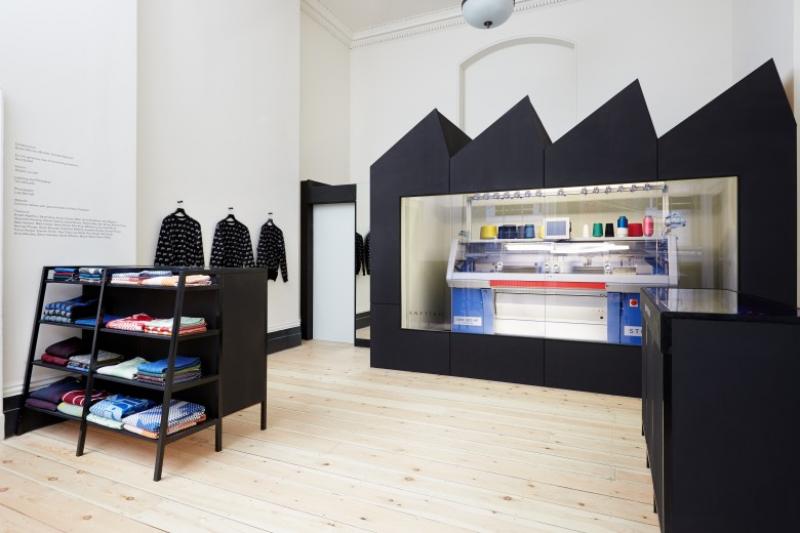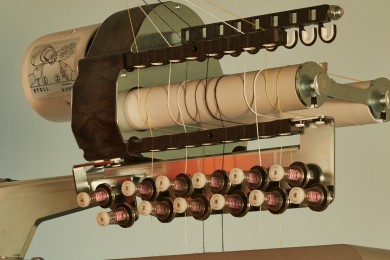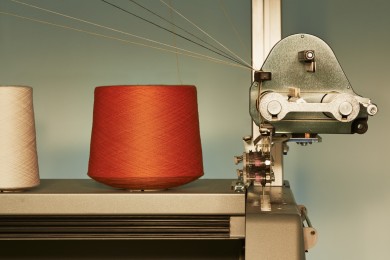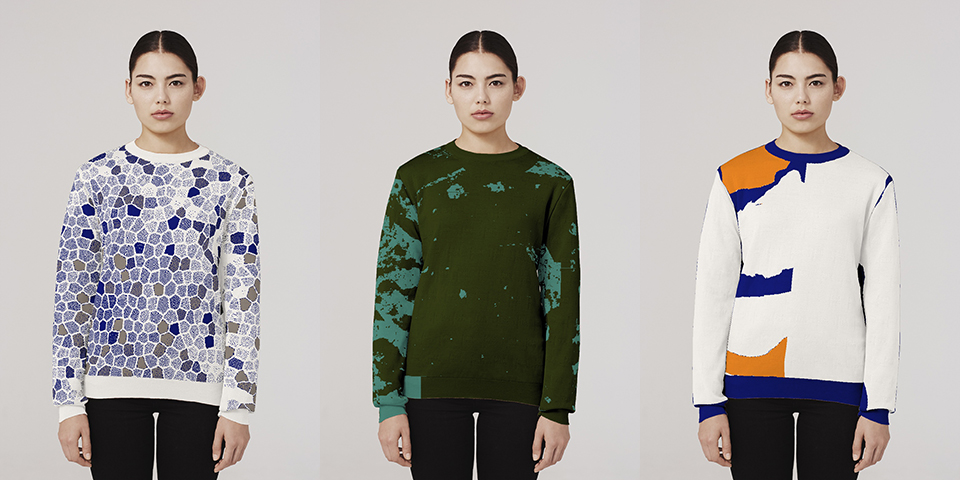We Made It: Digital Knitters Knyttan | reviews, news & interviews
We Made It: Digital Knitters Knyttan
We Made It: Digital Knitters Knyttan
Digital technology and craft principles creating one-off designs

Hand knitting has had a bit of a moment recently. Making your very own jumper was suddenly fashionable, but the knitter still had to follow, stitch by stitch, a pattern invented by someone else. And then, in 2013, along came Knyttan. Here was something quite different: the individual now contributed to the design rather than the making and the resulting garment had a professional finish.
 Knyttan was started by three Royal College of Art graduates, all still in their twenties, Ben Alun-Jones, Hal Watts and Kirsty Emery. Their original idea had been to develop products by the most up-to-date means but which recaptured the unique, personal qualities of pre-Industrial Revolution craft. Their first design company called Searu (Old English for “device” or “work of skill”) was sufficiently successful to provide set-up funding for Knyttan, another Anglo-Saxon word with a more obvious meaning.
Knyttan was started by three Royal College of Art graduates, all still in their twenties, Ben Alun-Jones, Hal Watts and Kirsty Emery. Their original idea had been to develop products by the most up-to-date means but which recaptured the unique, personal qualities of pre-Industrial Revolution craft. Their first design company called Searu (Old English for “device” or “work of skill”) was sufficiently successful to provide set-up funding for Knyttan, another Anglo-Saxon word with a more obvious meaning.
Searu had some prestigious clients - Google and will.i.am among them - but it was as a result of researching performance clothing for UK Sport before the Olympics in 2012 that they encountered modern industrial knitting machines. Alun-Jones says that that was “a light-bulb moment”. Here was something which could be adapted to work a bit like a 3D printer for wool, coded to produce different outcomes every time. That ideal of combining the personal with slick production – Alun Jones quotes Stan Davis's definition, in his book Future Perfect, of “mass customization” – became a possibility. In 2013 Searu ceased to exist and Knyttan was incorporated as a company.
Now Knyttan's creative director, Ben Alun-Jones began by studying electrical engineering at Imperial College, London, sponsored through his course by - rather surprisingly - the Ministry of Defence. Later he found researching for them in video surveillance, algorithms etc “conceptually interesting” but not entirely fulfilling. After encountering United Visual Artists, pioneers in using technology in London, “I realised I could use the same things for a different output”.
 Hal Watts was also at Imperial, studying mechanical engineering, but the two didn't know each other until they met as graduates on a design course at the RCA. Kirsty Emery was Hal Watts's flatmate and was finishing a women's wear course at the college. Already friends, the three got together professionally after the two men had design consultancy experience under their belts and Emery had been working for Parisian fashion houses. A newly invented code, a special language to programme the machine so that designs could be adapted at a finger's touch, brought their unique blend of technological savvy and creativity to fruition.
Hal Watts was also at Imperial, studying mechanical engineering, but the two didn't know each other until they met as graduates on a design course at the RCA. Kirsty Emery was Hal Watts's flatmate and was finishing a women's wear course at the college. Already friends, the three got together professionally after the two men had design consultancy experience under their belts and Emery had been working for Parisian fashion houses. A newly invented code, a special language to programme the machine so that designs could be adapted at a finger's touch, brought their unique blend of technological savvy and creativity to fruition.
Until last month Knyttan could be found running a six-month pop-up retail outlet at Somerset House, where they still have their studio-cum-office. For the first time, customers could choose in person from a series of basic designs (or “style guides”) for jumpers, scarves and blanket scarves and alter them as playfully as they liked by touching a tablet screen. Examples of finished work in every size, so that customer-designers could try them for fit, were displayed along with a wide range of high quality coloured Merino wools.
Style and colour decisions made, the orders were placed and the “factory”, the machine in the corner of the room, would produce a jumper in 90 minutes plus 45 minutes assembly time. Each garment was fitted with a unique label marked with the name of the purchaser and a number to indicate its place in the line of Knyttan productions from the very first thing they made. Each design is recorded so an owner can refer to the company in future if they want an exact copy. Until another retail outlet is established in a few months' time the process continues via Knyttan's website.
 A jumper costs £200, but Alun-Jones emphasises the outstanding quality of the yarn, the uniqueness of each garment and the fact that everyone who works for them receives proper UK wages “which isn't true of everyone in this business”. Meanwhile, the company is growing fast – the original three founders have been joined by four others – and they are raising their “first ever proper investment”. They expect to double in size by the end of the year. Innovation being part of their raison d'être, they are always ready to try new things. Recently, they have been experimenting with the Sprout, more interactive technology.
A jumper costs £200, but Alun-Jones emphasises the outstanding quality of the yarn, the uniqueness of each garment and the fact that everyone who works for them receives proper UK wages “which isn't true of everyone in this business”. Meanwhile, the company is growing fast – the original three founders have been joined by four others – and they are raising their “first ever proper investment”. They expect to double in size by the end of the year. Innovation being part of their raison d'être, they are always ready to try new things. Recently, they have been experimenting with the Sprout, more interactive technology.
But what do professional designers think about customers invading their territory? Alun-Jones admits that a few “have issues” but most “find it really exciting. Knitwear is the most complicated garment type and you usually need a minimum of 120 units to make a design pay”. This system is seen to be liberating.
Knyttan is a pioneering company with a distinctive philosophical outlook. They will not deliver beyond Europe because they believe in local production. Alun-Jones points out that about 10 % of the fashion industry's output is not used or sold, while Knyttan generates no waste at all. Beyond that, their ambition is nothing less than to try “to change the way retail works, using technology to create something but not seeing technology as the main thing”.
Explore topics
Share this article
The future of Arts Journalism
You can stop theartsdesk.com closing!
We urgently need financing to survive. Our fundraising drive has thus far raised £49,000 but we need to reach £100,000 or we will be forced to close. Please contribute here: https://gofund.me/c3f6033d
And if you can forward this information to anyone who might assist, we’d be grateful.

Subscribe to theartsdesk.com
Thank you for continuing to read our work on theartsdesk.com. For unlimited access to every article in its entirety, including our archive of more than 15,000 pieces, we're asking for £5 per month or £40 per year. We feel it's a very good deal, and hope you do too.
To take a subscription now simply click here.
And if you're looking for that extra gift for a friend or family member, why not treat them to a theartsdesk.com gift subscription?
more We made it
 We Made It: Guitar Maker Brian Cohen
The incredible one-man string band
We Made It: Guitar Maker Brian Cohen
The incredible one-man string band
 We Made It: Basket-maker Lois Walpole
Weaving works of art from 'ghost gear' and the detritus of consumerism
We Made It: Basket-maker Lois Walpole
Weaving works of art from 'ghost gear' and the detritus of consumerism
 We Made It: Horn Maker Tom Fisher
Bespoke horns, handcrafted in a Derbyshire cellar
We Made It: Horn Maker Tom Fisher
Bespoke horns, handcrafted in a Derbyshire cellar
 We Made It: Stufish Entertainment Architects
From U2 and Madonna to Chinese theatre and the Martian Fighting Machine
We Made It: Stufish Entertainment Architects
From U2 and Madonna to Chinese theatre and the Martian Fighting Machine
 We Made It: 'Carol' Costume Designer Sandy Powell
How she brought a melange of styles to Todd Haynes's sublime period romance
We Made It: 'Carol' Costume Designer Sandy Powell
How she brought a melange of styles to Todd Haynes's sublime period romance
 We Made It: Stuntwoman Tracy Caudle
Forget Evel Knievel: a well-crafted stunt is more about precision than daring
We Made It: Stuntwoman Tracy Caudle
Forget Evel Knievel: a well-crafted stunt is more about precision than daring
 We Made It: 'The Revenant' Production Designer Jack Fisk
How he stunningly recreated the authentic American frontier of 1823
We Made It: 'The Revenant' Production Designer Jack Fisk
How he stunningly recreated the authentic American frontier of 1823
 We Made It: Double Bass Maker Laurence Dixon
Love at first sight, a six-day week and the satisfaction of a job well done
We Made It: Double Bass Maker Laurence Dixon
Love at first sight, a six-day week and the satisfaction of a job well done
 We Made It: The Electric Recording Company
Pete Hutchison's quest for musical perfection on vinyl
We Made It: The Electric Recording Company
Pete Hutchison's quest for musical perfection on vinyl
 We Made It: Watchmaker Roger W Smith
The world-leading horologist keeping British watchmaking alive, crafting exquisite timepieces by hand
We Made It: Watchmaker Roger W Smith
The world-leading horologist keeping British watchmaking alive, crafting exquisite timepieces by hand
 We Made It: Concert hall acoustics
The RSNO have a new concert hall. The lead acoustician explains why it sounds so good
We Made It: Concert hall acoustics
The RSNO have a new concert hall. The lead acoustician explains why it sounds so good
 We Made It: The Headcaster App
Chris Chapman explains the genesis of his animated character app
We Made It: The Headcaster App
Chris Chapman explains the genesis of his animated character app

Add comment